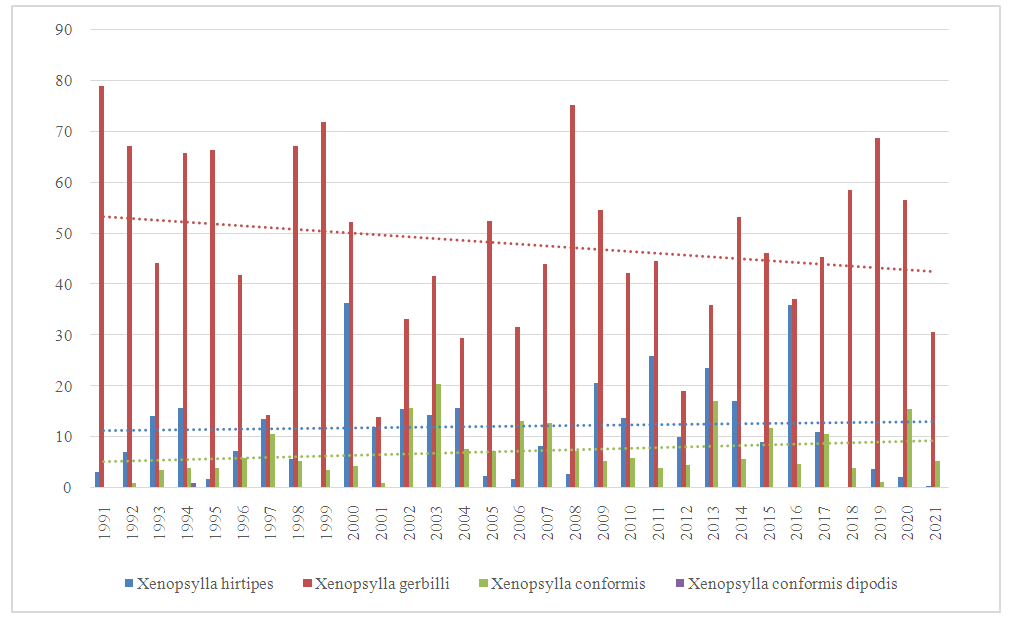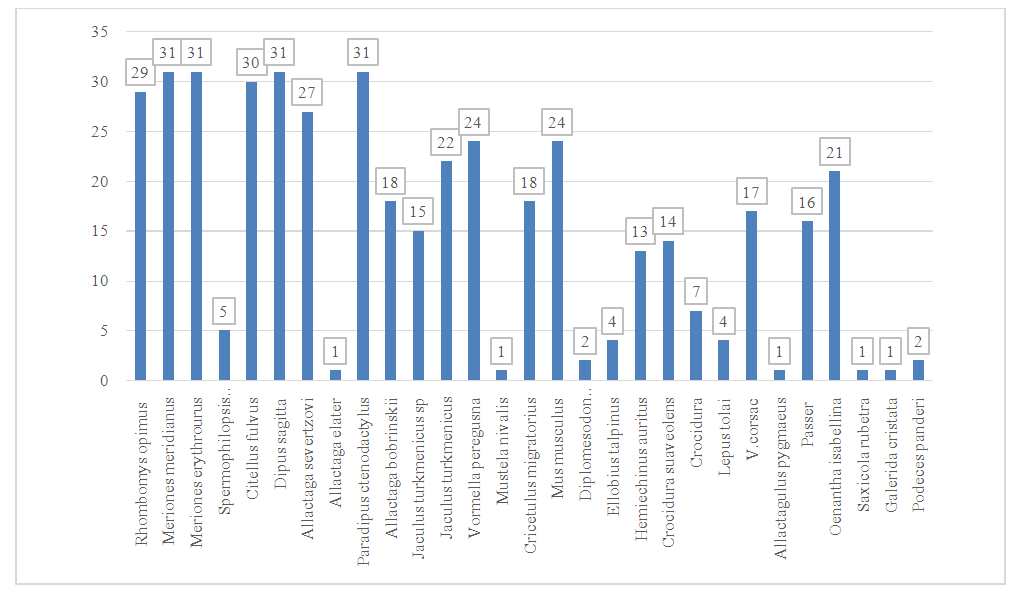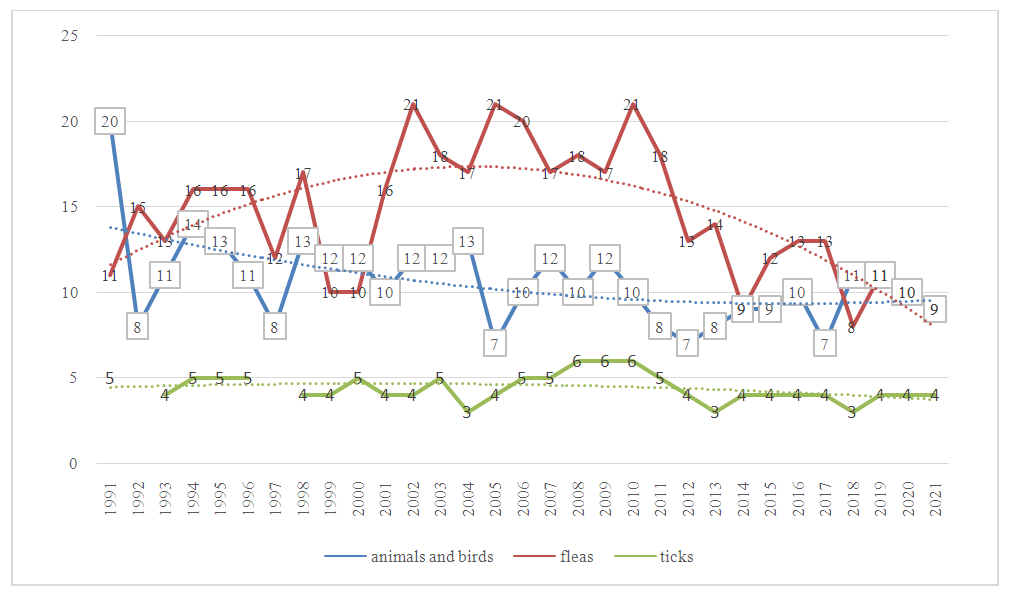-
Paper Information
- Next Paper
- Paper Submission
-
Journal Information
- About This Journal
- Editorial Board
- Current Issue
- Archive
- Author Guidelines
- Contact Us
American Journal of Medicine and Medical Sciences
p-ISSN: 2165-901X e-ISSN: 2165-9036
2023; 13(10): 1435-1443
doi:10.5923/j.ajmms.20231310.17
Received: Sep. 16, 2023; Accepted: Sep. 29, 2023; Published: Oct. 7, 2023

Some Data on the Records of Faunal Communities of the Central District of Kyzylkum
Bazarova Gulnara Rustamovna1, Nematov Aminjon Sardarovich2, Dmitriev Artyom Nikolaevich3
1"Sanitary-Epidemiological and Public Health Service of the Republic of Uzbekistan" of the Ministry of Health of the Republic of Uzbekistan, Tashkent, Republic of Uzbekistan
2"Center for the Development of Professional Qualifications of Medical Workers", Tashkent, Republic of Uzbekistan
3"Uchkuduk Anti-Plague Station" SI "NMMC Foundation", Uchkuduk, Uzbekistan
Copyright © 2023 The Author(s). Published by Scientific & Academic Publishing.
This work is licensed under the Creative Commons Attribution International License (CC BY).
http://creativecommons.org/licenses/by/4.0/

Epizootological examination was carried out on the areas in the Central District of Kyzylkum, 24 species of animals and birds of 5 species were studied, a total of 43937 specimens, ectoparasites – fleas 245197 specimens, ticks 20502 specimens. There is a tendency of degradation of the prevalence of animal species and fleas. The most adaptive representatives from the order Rodentia are the subfamily Gerbillinae, the family Sciuridae, fleas of the genera Xenopsylla, Nosopsyllus and Coptopsylla, ticks of the genus Hyalomma.
Keywords: Central district of Kyzylkum, Degradation of species diversity, Adaptive species
Cite this paper: Bazarova Gulnara Rustamovna, Nematov Aminjon Sardarovich, Dmitriev Artyom Nikolaevich, Some Data on the Records of Faunal Communities of the Central District of Kyzylkum, American Journal of Medicine and Medical Sciences, Vol. 13 No. 10, 2023, pp. 1435-1443. doi: 10.5923/j.ajmms.20231310.17.
1. Introduction
- The purpose of the work is to track the dynamics of the occurrence of fauna representatives in the catches on the territory of the Central District of Kyzylkum in the period from 1991 to 2021. For the analysis, archival epizootological data of field studies were used on the territory of the Central District of the anti-plague department of the city of Zarafshan of the Republican Center for Plague Prevention of the Ministry of Health of the Republic of Uzbekistan and the anti-plague station of the medical and sanitary unit of the regional department "Uchkuduk" of the State Institution "NMMC Fund". The inspection of the Kyzylkum territory supervised by these institutions was carried out on the basis and in accordance with the annual Work Plans approved by the director of the Republican Plague Prevention Center of the Ministry of Health of the Republic of Uzbekistan. The data presented for analysis are based on the results of a survey of the Central section of the Kyzylkum plague focus in 1991-2021, in the spring-summer and autumn-winter seasons, from 1.2 decades of March to 1 decade of June and from 2.3 decades of September to 2, 3rd decade of November. The study of the material was carried out in accordance with the methods generally accepted in the anti-plague service.For the entire analyzed period, based on the available data, 24 species of animals and birds of 5 species, 43937 specimens in total, ectoparasites - fleas 245197 specimens, ticks 20502 specimens were caught and studied [1-6]. The Modern landscape complexes of the Central Kyzylkum are a fragile and less stable formation, where intercomponent relationships are very weak and easily destroyed under the influence of external factors. This is due to the sharp contrast of environments and the peculiar specificity of natural conditions. At the present stage of development of the geosystems of the Central Kyzylkum, their transformation and dynamics are significantly influenced by two groups of factors: natural and anthropogenic. Natural development is formed as a result of the interaction and interdependence of numerous factors, such as geological, geomorphological, geoecological, hydrogeological, climatic, hydrological, soil, plant and zoogenic. Anthropogenic factors mainly include forms of organization of human economic activity: cutting down wood and shrubs for fuel, excessive grazing without taking into account the anthropogenic load on such fragile arid complexes, uncontrolled hunting, mining without subsequent reclamation of technogenic complexes. The region under study is the main center of not only grazing, but also the mining industry, under the influence of which mining landscapes arose. Among the latter, young, mature and old mining landscapes can be distinguished according to the time of occurrence.
2. Materials and Methods
- These geocomplexes - waste heaps, wastelands, tailings, rock dumps, devoid of soil and vegetation cover, contribute to the intensification of the desertification process not only in the mining areas, but also in the nearby sandy landscapes [8].In accordance with the scheme of epidemiological zoning of the Kyzylkum, the zone of its Central District, according to the type of economic development, is an interlacing of territories (zones) of livestock breeding, agricultural and livestock breeding and industrial livestock breeding [12].Biocenotically, the territory of the Central District of the Kyzylkum corresponds to the Turan psammophilous community [7,12].Animals exist in the conditions of certain landscapes, where the degree of favorable environment depends on many factors, among which abiotic (physical) factors play an important role. At present, the extremely negative impact on the composition of animal populations of global predictors is most clearly manifested - solar activity, the greenhouse effect, as a result, aridity, lowering of groundwater, etc [9].The complexity of the impact of the above regulators is reflected in the qualitative and quantitative composition of the fauna of the Kyzylkum biocenoses.For the period from 1991 to 2023, according to the cumulative results of field studies of the territories of the Central District of the Kyzylkum, it was established that the dominant in catches were rodents were the subfamily (family) of gerbils-Gerbillinae (94.28%), of which 71.04% were large gerbils- Rhombomys opimus (64.1% occurrence index), 18.1% Meriones meridianus (18.2% occurrence index) and 10.6% Meriones erythrourus (9.4% occurrence index). The genus of ground squirrels of the Sciuridae family in catches amounted to 3.3%, where the yellow ground squirrel - Citellus fulvus (84.04%) prevailed, the occurrence index was 4.5%, the remaining 15.9% was the fine-toed ground squirrel - Spermophilopsis leptodactylus (occurrence index - 0.68%). The jerboa family - Dipodidae accounted for 0.76%, where 33.8% was the upland jerboa - Dipus sagitta (occurrence index - 0.45%), 32.9% - small jerboa - Allactaga elater (occurrence index - 0.4%) , 16.9% - comb-toed jerboa-Paradipus ctenodactylus (occurrence index - 0.12%), 12.7% - Severtsov's jerboa - Allactaga severtzovi (occurrence index - 0.3%) and 2.06% - jerboa sp-Jaculus turkmenicus sp (occurrence index - 0.15%), other species of jerboas - Allactaga bobrinskii et Jaculus turkmenicus, amounted to 0.89% and 0.59% each (occurrence index - 0.1 and 0.09%), respectively. It should be noted the percentage ratio in the captures of the brownie-Mus musculus mouse with an occurrence index of 1.63%, which is associated with the specialization of the tactics of surveying settlements by anti-plague institutions. Among the birds (occurrence index - 11.7%) in catches, the dancer's Wheatear (Oenantha isabellina) dominated - 73.5% (occurrence index - 0.13%).
 | Diagram 1 |
 | Diagram 2 and 3. Percentage composition of predominance in catches of rodent species of the families of gerbils and jerboas |
 | Diagram 4. Dynamics of occurrence of the subfamily Gerbillinae |
 | Diagram 5. Aggregate data (%) on occurrence indices among fleas |
 | Diagram 6. Distribution of the main genera of fleas by occurrence |
 | Diagram 7. Dynamics of occurrence (in %) of fleas of the genus Xenopsylla |
 | Diagram 8. Dynamics of occurrence (in %) of fleas of the genus Coptopsylla |
 | Diagram 9. Dynamics of occurrence (in %) of fleas of the subgenus Nosopsyllus |
 | Diagram 10. ticks, occurrence, in % |
 | Diagram 11. Dynamics of occurrence (in %) of ticks on the territory of the Central District of Kyzylkum |
 | Diagram 12. Frequency of occurrence in catches of various species of rodents, predators, birds in the period 1991-2021 |
 | Diagram 13. The frequency of occurrence in collections of ectoparasites of various types of fleas and ticks in the period 1991-2021 |
 | Diagram 14. The frequency of occurrence of animal and bird species, ectoparasites from the entire spectrum of the studied |
3. Results and Discussions
- From the assessment of these graphs, a clearly traceable trend of degradation of the prevalence of animal species and fleas within the surveyed area follows, starting from 2009-2010, when the number of species of captured rodents decreased to 9 species out of 29, on average, rodents Rhombomys opimus, Meriones meridianus, Meriones erythrourus, Citellus fulvus, Allactaga elater, Mus musculus and Cricetulus migratorius. It should be noted that representatives of the order of birds have not been found in catches since 2009. Among fleas, in this period, it decreased in collections to 11 species, on average, out of 34, among which Xenopsylla gerbilli, Xenopsylla conformis, Xenopsylla hirtipes, Coptopsylla lamellifer and Coptopsylla olgae, and Nosopsyllus laeviceps, Echidnophaga oschanini, Stenoponia vlasovi were noted for stable dynamics of occurrence.
4. Conclusions
- In addition, taking into account the data on the increase in the proportion of some representatives of the order of ectoparasites, we can conclude that the most adaptive representatives, namely, fleas of the genera Xenopsylla gerbilli et hirtipes, Nosopsyllus turkmenicus et tersus, Coptopsylla olgae et trispinus; ticks of the genus Hyalomma, less Ixodes, Haemaphysalis, Ornithodoros.The authors confirm that there is no conflict of financial/non-financial interests associated with writing the article.
 Abstract
Abstract Reference
Reference Full-Text PDF
Full-Text PDF Full-text HTML
Full-text HTML